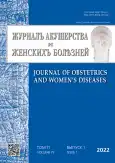The role of the HLA-G gene and its expression in the genesis of recurrent miscarriage
- Authors: Bakleycheva M.O.1, Bespalova O.N.1, Ivashchenko T.E.1
-
Affiliations:
- The Research Institute of Obstetrics, Gynecology and Reproductology named after D.O. Ott
- Issue: Vol 71, No 1 (2022)
- Pages: 101-108
- Section: Reviews
- URL: https://journals.rcsi.science/jowd/article/view/76384
- DOI: https://doi.org/10.17816/JOWD76384
- ID: 76384
Cite item
Abstract
This review summarizes the results of modern foreign and domestic clinical studies that provide information on the importance of the main histocompatibility complex (HLA), in general, and the expression of non-classical HLA-G molecules on trophoblast cells, in particular, in the physiological course of early pregnancy. The HLA-G gene has central functions in the processing and presentation of antigen and inhibits the receptor of NK cells, which leads to a decrease in the immune response at the fetal-maternal interface and provides immune tolerance to the fetus from the maternal body. HLA-G expression is dependent on combinations of transcription factors, miRNAs, and environmental factors. Based on this, more than a hundred studies have been put into clarifying how HLA-G expression influences the development of pregnancy complications, such as recurrent pregnancy losses, in which immunological factors are believed to play a crucial role.
Keywords
Full Text
##article.viewOnOriginalSite##About the authors
Margarita O. Bakleycheva
The Research Institute of Obstetrics, Gynecology and Reproductology named after D.O. Ott
Email: bakleicheva@gmail.com
ORCID iD: 0000-0002-0103-8583
Scopus Author ID: 57203248029
MD, junior research schientist of Department of obstetrics and perinatology
Russian Federation, 3, Mendeleevskaya Line, Saint Petersburg, 199034Olesya N. Bespalova
The Research Institute of Obstetrics, Gynecology and Reproductology named after D.O. Ott
Email: shiggerra@mail.ru
ORCID iD: 0000-0002-6542-5953
SPIN-code: 4732-8089
MD, Dr. Sci. (Med.)
Russian Federation, 3, Mendeleevskaya Line, Saint Petersburg, 199034Tatyana E. Ivashchenko
The Research Institute of Obstetrics, Gynecology and Reproductology named after D.O. Ott
Author for correspondence.
Email: tivashchenko2011@mail.ru
ORCID iD: 0000-0002-8549-6505
PhD, Dr. Sci. (Biol.), Professor
Russian Federation, 3, Mendeleevskaya Line, Saint Petersburg, 199034References
- Djurisic S, Hviid TV. HLA Class Ib molecules and immune cells in pregnancy and preeclampsia. Front Immunol. 2014;5:652. doi: 10.3389/fimmu.2014.00652
- Bakleicheva MO, Bespalova ON, Ivashchenko TE. Role of class I HLA (G, E, and C) expression in early reproductive losses. Obstetrics and Gynecology. 2020;(2):30−36. (In Russ.). doi: 10.18565/aig.2020.2.30-36
- Carosella ED, Ploussard G, LeMaoult J, Desgrandchamps F. A systematic review of immunotherapy in urologic cancer: Evolving roles for targeting of CTLA-PD-1/PD-L1, and HLA-G. Eur Urol. 2015;68(2):267−279. doi: 10.1016/j.eururo.2015.02.032
- Szekeres-Bartho J, Markert UR, Varla-Leftherioti M. Immunology in reproduction. J Reprod Immunol. 2015;108:1. doi: 10.1016/j.jri.2015.03.003
- de Wynter EA, Testa NG. Interest of cord blood stem cells. Biomed Pharmacother. 2001;55(4):195−200. doi: 10.1016/s0753-3322(01)00049-x
- Serova LD. Immunologicheskij HLA-status u zhenshhin s privychnym nevynashivaniem beremennosti: metodicheskie rekomendacii. Moscow, 1998. (In Russ.)
- Steinbrook R. The cord-blood-bank controversies. N Engl J Med. 2004;351(22):2255−2257. doi: 10.1056/NEJMp048283
- Ferreira LMR, Meissner TB, Tilburgs T, Strominger JL. HLA-G: At the interface of maternal-fetal tolerance. Trends Immunol. 2017;38:272–286. doi: 10.1016/j.it.2017.01.009
- Choudhury SR, Knapp LA. Human reproductive failure II: immunogenetic and interacting factors. Hum Reprod Update. 2001;7(2):135−160. doi: 10.1093/humupd/7.2.135
- Lorentzen DF, Iwanaga KK, Meuer KJ, et al. A 25% error rate in serologic typing of HLA-B homozygotes. Tissue Antigens. 1997;50(4):359−365. doi: 10.1111/j.1399-0039.1997.tb02888.x
- Komlos L, Zamir R, Joshua H, Halbrecht I. Common HLA antigens in couples with repeated abortions. Clin Immunol Immunopathol. 1977;7(3):330−335. doi: 10.1016/0090-1229(77)90066-6
- Christiansen OB, Ring M, Rosgaard A, et al. Association between HLA-DR1 and -DR3 antigens and unexplained repeated miscarriage. Hum Reprod Update. 1999;5(3):249−255. doi: 10.1093/humupd/5.3.249
- Dahl M, Klitkou L, Christiansen OB, et al. Human leukocyte antigen (HLA)-G during pregnancy part II: associations between maternal and fetal HLA-G genotypes and soluble HLA-G. Hum Immunol. 2015;76(4):260−271. doi: 10.1016/j.humimm.2015.01.015
- Plaks V, Rinkenberger J, Dai J, et al. Matrix metalloproteinase-9 deficiency phenocopies features of preeclampsia and intrauterine growth restriction. Proc Natl Acad Sci USA. 2013;110(27):11109−11114. doi: 10.1073/pnas.1309561110
- Zidi I, Rizzo R, Bouaziz A, et al. sHLA-G1 and HLA-G5 levels are decreased in Tunisian women with multiple abortion. Hum Immunol. 2016;77:342–345. doi: 10.1016/j.humimm.2016.01.019
- Ikeno M, Suzuki N, Kamiya M, et al. LINE1 family member is negative regulator of HLA-G expression. Nucleic Acids Res. 2012;40(21):10742−10752. doi: 10.1093/nar/gks874
- Bespalova O, Bakleicheva M, Ivashchenko T, et al. Expression of HLA-G and KIR2DL4 receptor in chorionic villous in missed abortion. Gynecol Endocrinol. 2020;36(Supp1):43−47. doi: 10.1080/09513590.2020.1816716
- Akhter A, Das V, Naik S, et al. Upregulation of HLA-G in JEG-3 cells by dexamethasone and hydrocortisone. Arch Gynecol Obstet. 2012;285(1):7−14. doi: 10.1007/s00404-011-1880-3
- Barrientos G, Toro A, Moschansky P, et al. Leptin promotes HLA-G expression on placental trophoblasts via the MEK/Erk and PI3K signaling pathways. Placenta. 2015;36(4):419−426. doi: 10.1016/j.placenta.2015.01.006
- Gregori S, Amodio G, Quattrone F, Panina-Bordignon P. HLA-G Orchestrates the early interaction of human trophoblasts with the maternal niche. Front Immunol. 2015;6:128. doi: 10.3389/fimmu.2015. 00128
- Wang X, Li B, Wang J, et al. Evidence that miR-133a causes recurrent spontaneous abortion by reducing HLA-G expression. Reprod Biomed Online. 2012;25(4):415−424. doi: 10.1016/j.rbmo.2012.06.022
- Wu ZS, Wang CQ, Xiang R, et al. Loss of miR-133a expression associated with poor survival of breast cancer and restoration of miR-133a expression inhibited breast cancer cell growth and invasion. BMC Cancer. 2012;12:51. doi: 10.1186/1471-2407-12-51
- Guo W, Fang L, Li B, et al. Decreased human leukocyte antigen-G expression by miR-133a contributes to impairment of proinvasion and proangiogenesis functions of decidual NK cells. Front Immunol. 2017;8:741. doi: 10.3389/fimmu.2017.00741
- Rokhafrooz S, Ghadiri A, Ghandil P, et al. Association between HLA-G 14bp gene polymorphism and serum sHLA-G protein concentrations in preeclamptic patients and normal pregnant women. Immunol Invest. 2018;47:558–568. doi: 10.1080/08820139.2018.1467925
- Alenichev AS, Nasyhova JuA, Ivashhenko EJe, Baranov VS. Harakteristika geneticheskoj struktury populjacii Severo-Zapadnogo regiona RF po genu HLA-G. Jekologicheskaja genetika. 2014;12(2):74−80. (In Russ.)
Supplementary files










